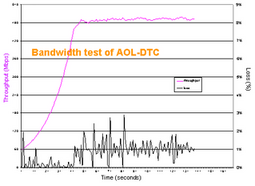neal young / Garg02Online
-
 Congestion control in the current Internet is accomplished
mainly by TCP/IP. To understand the macroscopic network
behavior that results from TCP/IP and similar end-to-end
protocols, one main analytic technique is to show that the
the protocol maximizes some global objective function of the
network traffic.
Congestion control in the current Internet is accomplished
mainly by TCP/IP. To understand the macroscopic network
behavior that results from TCP/IP and similar end-to-end
protocols, one main analytic technique is to show that the
the protocol maximizes some global objective function of the
network traffic.
Here we analyze a particular end-to-end, MIMD (multiplicative-increase, multiplicative-decrease) protocol. We show that if all users of the network use the protocol, and all connections last for at least logarithmically many rounds, then the total weighted throughput (value of all packets received) is near the maximum possible. Our analysis includes round-trip-times, and (in contrast to most previous analyses) gives explicit convergence rates, allows connections to start and stop, and allows capacities to change.
An application explained in the paper is multi-path bandwidth measurement.
© Copyrights are reserved by the publishers.
Download for personal and limited academic use only.